Homemade Pumpkin Puree
Homemade Pumpkin Puree: simple and easy way to make applesauce-consistency fresh pumpkin puree to store in refrigerator or freeze for up to a year. Pumpkin puree can be used in many different desserts and meals and the taste is always delightful!
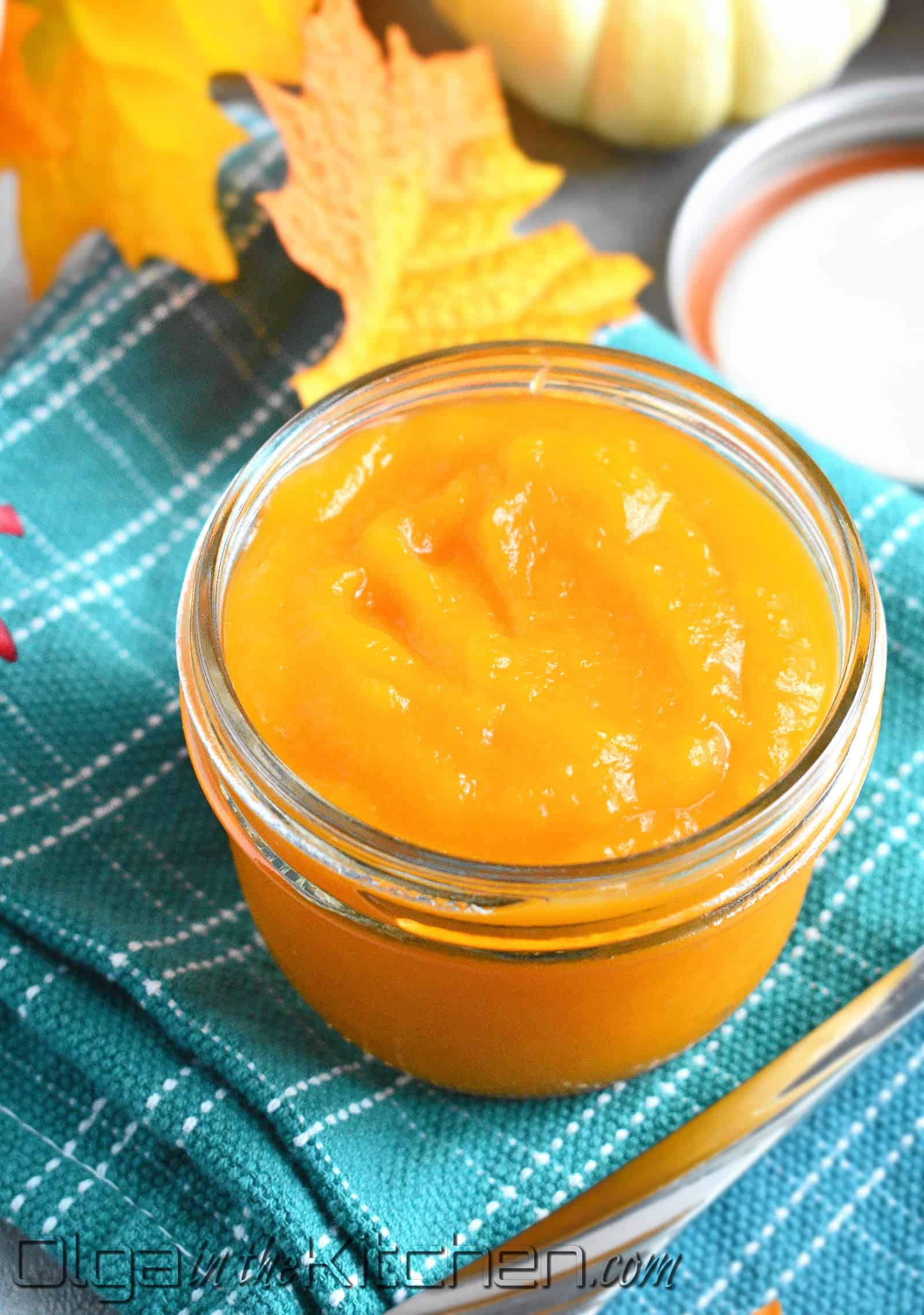
This post may contain affiliate links. Read my disclosure policy.
Homemade Pumpkin Puree Recipe:
Making homemade pumpkin puree is extremely easy! The texture is applesauce-consistency and the color of puree is very light and bright orange. While most people like to use the baking method, my family had always used the stovetop method to can in glass jars. These keep for up to a year in the refrigerator without going bad. For other storage option, we freeze it for up to 1 year.
We boil the puree twice to remove all the bacteria from the puree and puree stays fresh in sterilized glass jars for up to a year in refrigerator. Just the perfect amount to enjoy pumpkin bread through the year until next time you make the puree.
I also think that with boiling method, the puree turns out very soft, like a very thin applesauce and you don’t get that with the baking method. It’s very easy to put the pumpkin puree into jars as the texture is not as thick as store-bought and it covers every bit of space in the jar.
We don’t celebrate Halloween, but I love fall and it’s my favorite season of the year because of its colorful beauty outside of my window and the crisp air. I also love baking with pumpkins probably more than most people all-year-long.
Pumpkin Puree for Pumpkin Bread:
My mom’s famous Ukrainian Pumpkin Bread is the main reason I started canning pumpkin puree. We all absolutely love this bread and mom makes it for us for major holidays every year. She would make a round giant loaf for every child and it’s the traditional she continues and we love.
This bread does not work with store-bought canned pumpkin so homemade pumpkin puree is a must! With homemade pumpkin puree, pumpkin bread turns out light and fluffy, with a light yellow-dish color, while it’s everything the opposite if using store-bought puree.
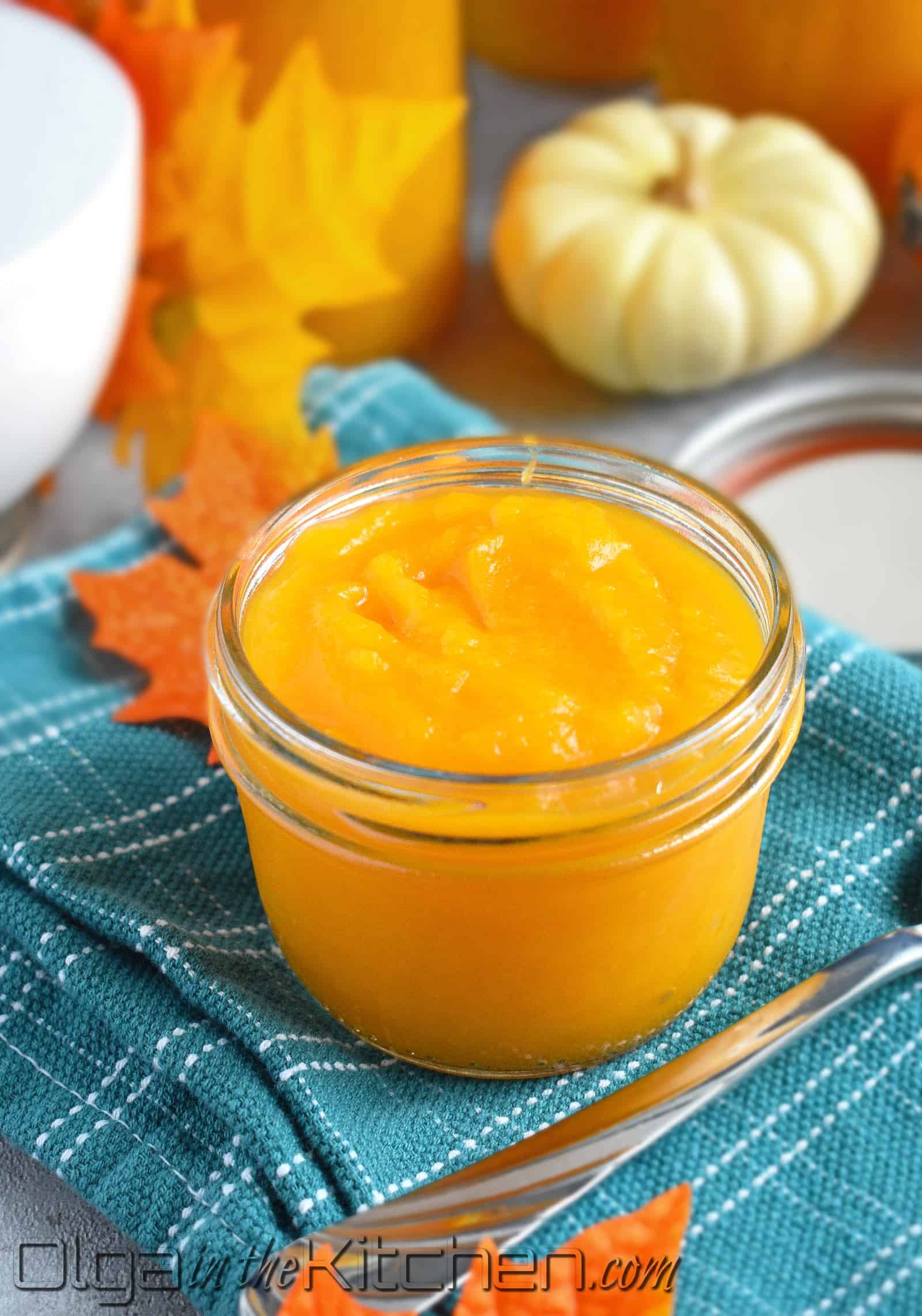
Storing Pumpkin Puree
There are few ways to store pumpkin puree for fresh and safe usage later. Opened jars would be used within a week. Canned twice-boiled pumpkin puree in sterilized jars can be stored in refrigerator for up to a year. Baked pumpkin should be stored only 3 months in refrigerator.
To freeze pumpkin puree, I do one cup in a small freezer bag and freeze up to a year. Frozen homemade pumpkin puree is always slightly watery than the puree you buy from store in cans or not frozen, but it works great in recipes calling for homemade pumpkin puree, even if there’s a bit extra water after thawing the puree.
Pumpkin Puree Ingredients:
- Pumpkin (any size, I used about 14”)
- Water (cold, warm or hot)
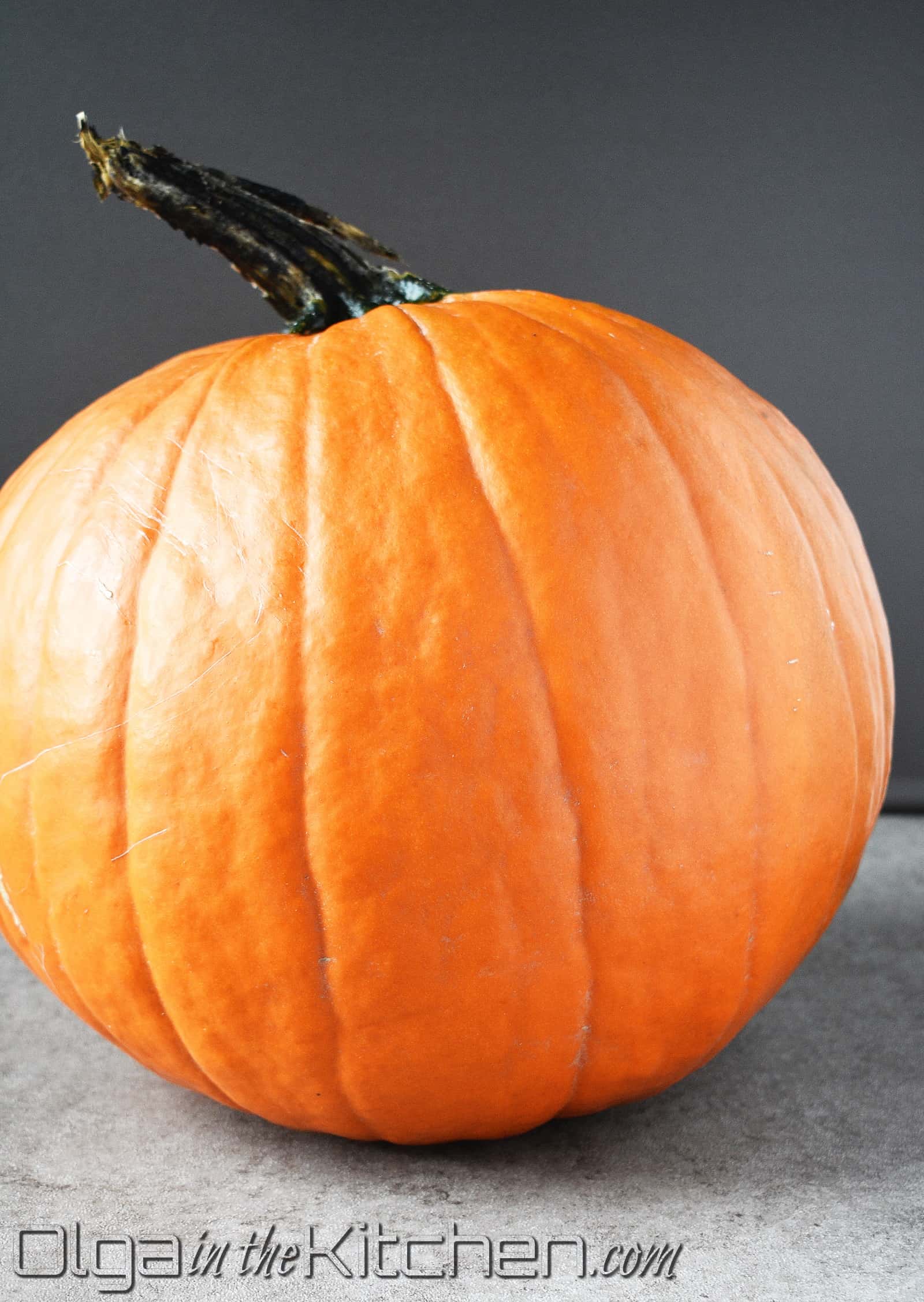
How to Make Pumpkin Puree:
1. Wash the pumpkin with warm water and use sponge if needed to get any dirt off (you don’t want the dirt accidentally getting into puree). Using a sharp knife, cut the pumpkin in half and remove the seeds and scrape out the pumpkin pulp. (Keep the seeds refrigerated until you’re ready to toast them!)
Cut the pumpkin into any smaller sizes, cubes or rectangles, peel with a thin knife, cut into 2” cubes and add to a large pot. Add cold, warm or hot water about 2” below pumpkin cubes – it doesn’t have to cover all the pumpkin. Bring the pot to a boil over high heat, lower the heat to low and cook for 1 hour or until you can easily pierce the pumpkin cubes with a fork.
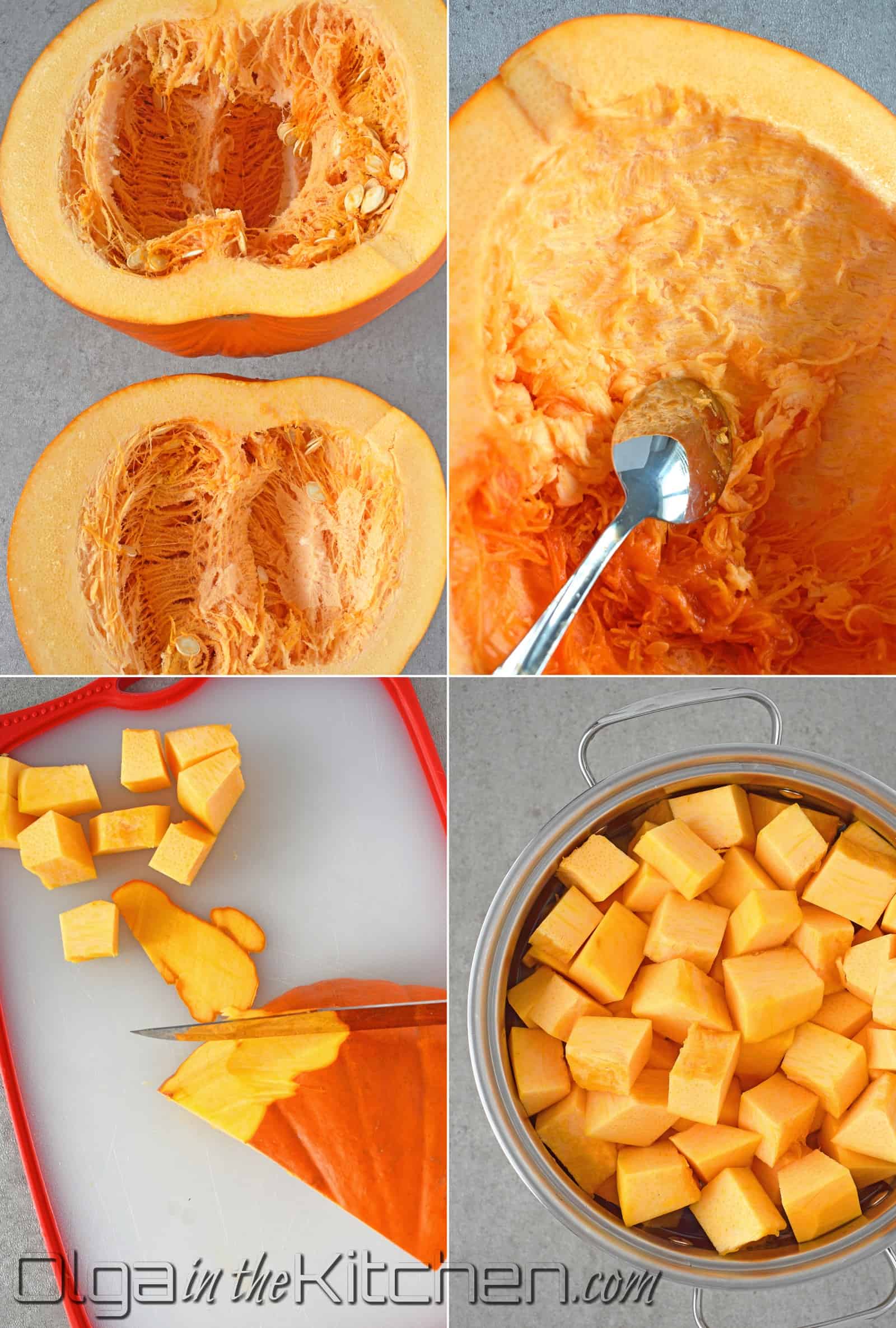
How to Sterilize Jars and Lids:
2. While pumpkin is cooking, preheat the oven to a 215°F. Wash jars and lids with a warm soapy water. Place the jars into the oven on the center rack upside down and dry them for 20 mins or until completely dry (20 mins always works for me). Boil lids in a medium pot for 4-5 mins. Drain the water and transfer hot lids to a kitchen towel to dry while pumpkin is cooking.
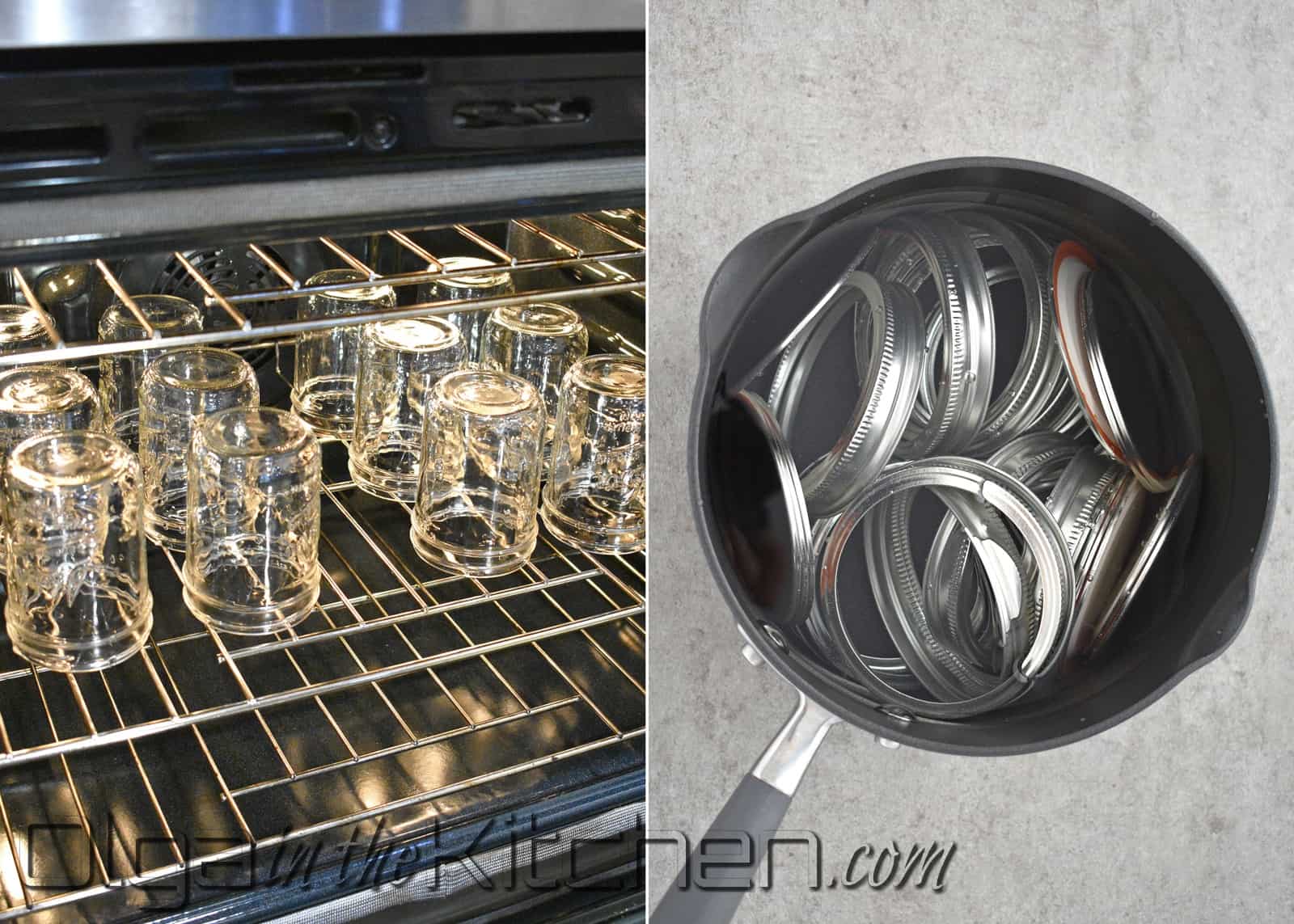
3. Once pumpkin is cooked, drain most water (water will keep running little by little, but drain the huge flow) and set the pumpkin to cool a bit so you don’t blunt the blender knives. Once cooled, using a blender or a food processor, puree the cooked pumpkin in batches until applesauce consistency (1-2 mins in blender worked great). Remove any remaining water from the pot and pour the pureed pumpkin back into the pot. Do it fast to avoid major splashing. Bring the pumpkin puree to a boil over low heat (#4 on my cook-top) and cook/boil for another 10-15 mins. (Puree will start boiling almost right away, but the way to know when it’s really boiling is when the puree has huge bubbles, the top of the lid is all splashed up and the pot is really hot).
Spoon pumpkin puree into jars. Wipe the rim with a paper towel to make sure it’s free of any puree and tightly close each jar right away (but not too tight that the jar can’t handle).
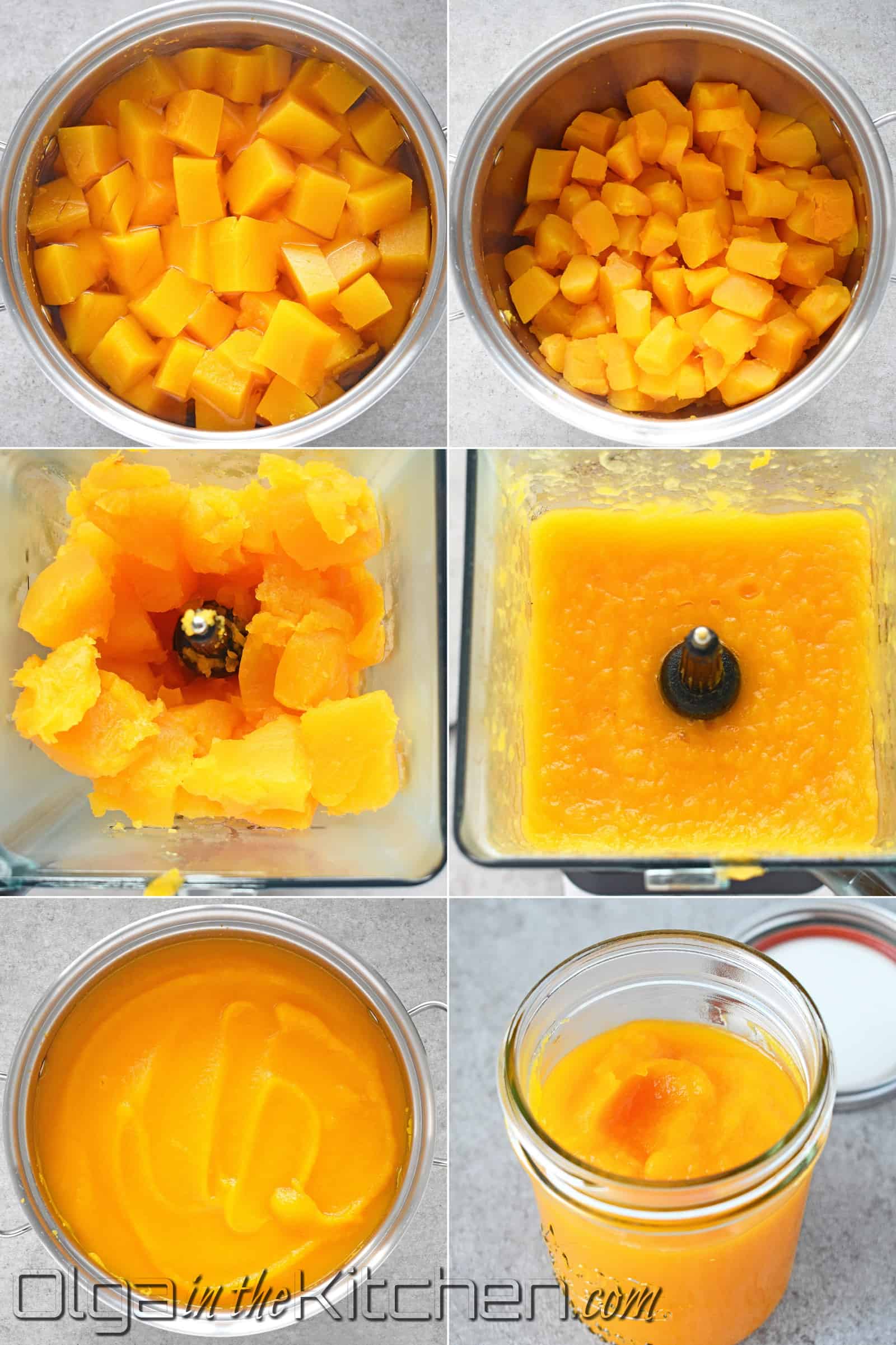 4. Cover jars with couple kitchen towels until completely cooled – it might take a day. Pumpkin puree can be used right away, stored in refrigerator or in the freezer for up to a year.
4. Cover jars with couple kitchen towels until completely cooled – it might take a day. Pumpkin puree can be used right away, stored in refrigerator or in the freezer for up to a year.
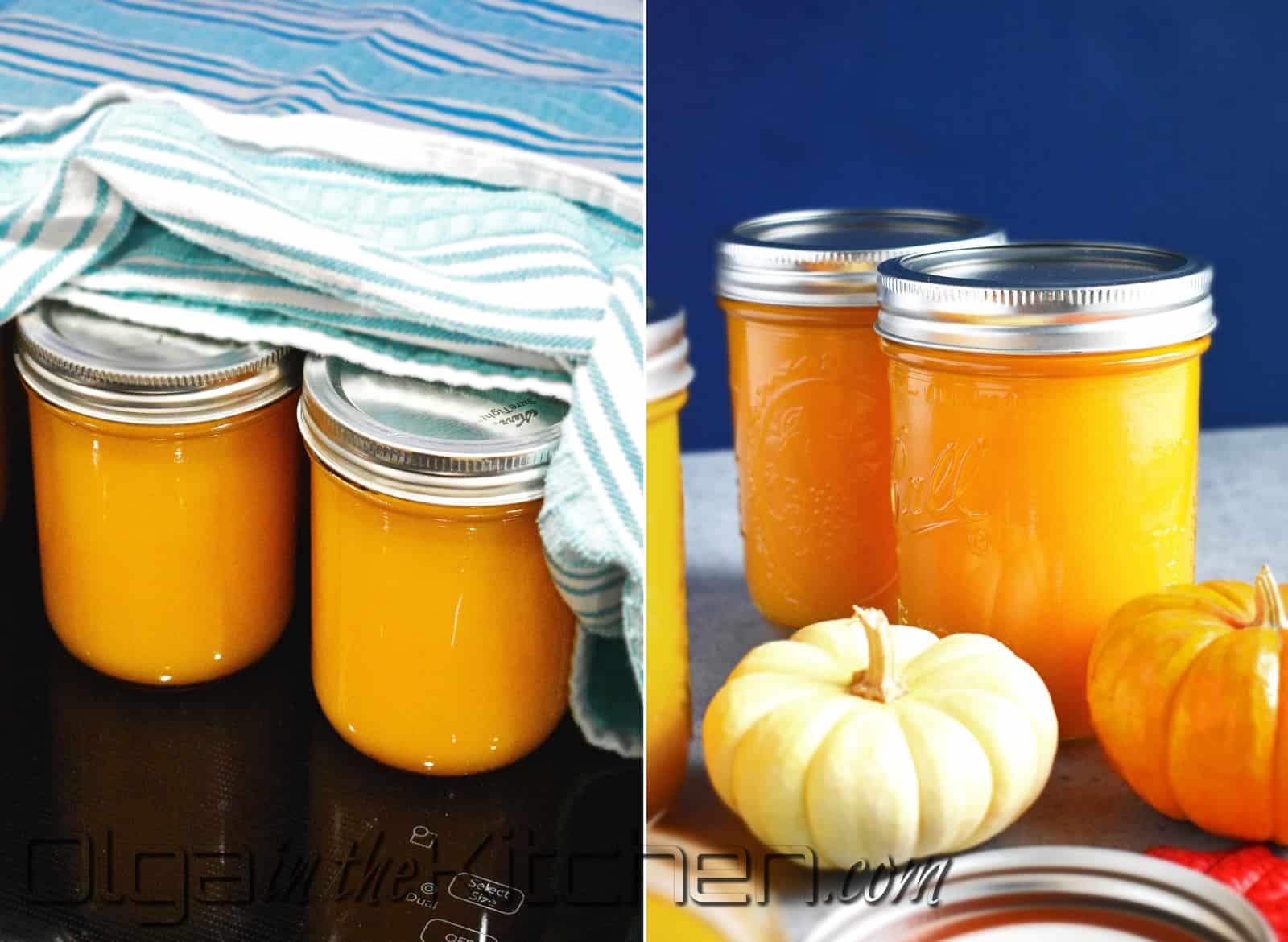
More Tips from Olga:
- Perfect Hard-Boiled Eggs (Every Time) – the only method we use with excellent results each time
- Buying, Grinding and Storing Ground Pork Meat – learn to have ground meat in freezer at all times
- Dulce de Leche (Cooked Condensed Milk) – thick consistency every time, great to use in fillings
- Oven Dried Bread – store for months to use in meatballs
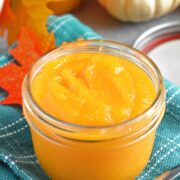
Making and Canning Homemade Pumpkin Puree
Ingredients
- pumpkin, any size, I used about 14”
- water, cold, warm or hot
Instructions
- Wash the pumpkin with warm water and use sponge if needed to get any dirt off (you don’t want the dirt accidently getting into puree).
- Using a sharp knife, cut the pumpkin in half and remove the seeds and scrape out the pumpkin pulp. (Keep the seeds refrigerated until you’re ready to toast them!)
- Cut the pumpkin into any smaller sizes, cubes or rectangles, peel with a thin knife, cut into 2” cubes and add to a large pot. (You might need couple pots.) Add cold, warm or hot water (cold will take longer to get to a boil) about 2” below pumpkin cubes – it doesn’t have to cover all the pumpkin.
- Bring the pot to a boil over high heat, lower the heat to low and cook for 1 hour or until you can easily pierce the pumpkin cubes with a fork. (prolonged cooking will remove bacteria, if any, for prolonged storage)
- STERILIZING JARS and LIDS: While pumpkin is cooking, preheat the oven to a 215°F. Wash jars and lids with a warm soapy water. Place the jars into the oven on the center rack upside down and dry them for 20 mins or until completely dry (20 mins always works for me). Remove hot jars with pot holders onto kitchen towel – keep them upside down to prevent any lint from getting inside the jars. Boil lids in a medium pot for 4-5 mins. Drain the water and transfer hot lids to a kitchen towel to dry while pumpkin is cooking.
- Once pumpkin is cooked, drain most water (water will keep running little by little, but drain the huge flow) and set the pumpkin to cool a bit so you don’t blunt the blender knives. Once cooled, using a blender or a food processor, puree the cooked pumpkin in batches until applesauce consistency (1-2 mins in blender worked great). Remove any remaining water from the pot and pour the pureed pumpkin back into the pot. Do it fast to avoid major splashing.
- Bring the pumpkin puree to a boil over low heat and cook/boil for another 10-15 mins. (Puree will start boiling almost right away, but the way to know when it’s really boiling is when the puree has huge bubbles, the top of the lid is all splashed up and the pot is really hot). Spoon pumpkin puree into jars. Wipe the rim with a paper towel to make sure it’s free of any puree and tightly close each jar right away (but not too tight that the jar can’t handle).
- Cover jars with couple kitchen towels until completely cooled – it might take a day.
- Pumpkin puree can be used right away, stored in cooler temperature, refrigerator or freezer for up to a year.

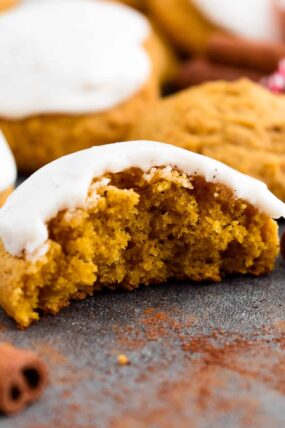
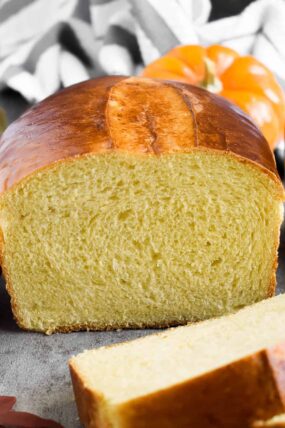
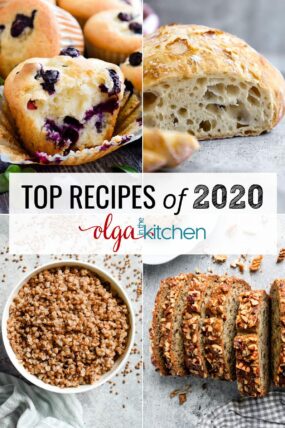
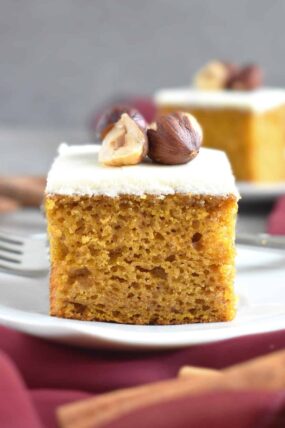
Cheryl says:
What size jars should be used?
Olga in the Kitchen says:
Hi Cheryl! It’s your personal preference. I usually go for 16oz jars because it’s more practical for me, but you can do smaller or larger. Keep in mind that If you do decide to use larger jars and when you open to put it into use, you would want to use it within few days so the puree doesn’t go bad.
Johnnie Sturgess says:
What would be a recommendation for time in a pressure canner if a person wanted to can the pumpkin that way? No matter what someone says about not doing it, thanks for any information!
Olga in the Kitchen says:
Hy Johnnie! I don’t own a pressure canner and without experimenting myself, I wouldn’t know. If you do decide to try it, please share with us the outcome. Thanks!
Margretta says:
Would boiling after roasting work this way as well?
Olga in the Kitchen says:
Hi Margretta! I wouldn’t recommend it. I haven’t tried it myself, but one of my sisters did couple years ago and the jars wouldn’t stay long, the puree went bad – turned white. Boiling from beginning like in recipe sterilizes it and that’s what keeps the finished puree long lasting without going bad. Hope this helps!
Bailey Rasmussen says:
If I don’t hear them pop how do I know if they sealed properly? Should I place them in a water bath additionally?
Olga in the Kitchen says:
With any kind of canning, when you push in the center of the lid, it should not pop up and down. If you do hear a popping or clicking when pressing, the seal did not form properly and the jar must be refrigerated. However, this recipe is forgiving as we are keeping it in the fridge anyway. Unless you are planning to store canned pumpkin puree in your pantry, then you definitely need to check that it’s not popping up and down when you press.
Nadia says:
I make pumpkin puree using your recipe for boiling these past couple years, and it’s our preferred way. Makes baked goods more fluffy and not dense. We have 3 quart jars left from last autumn in our fridge and they are perfect, not leaking, not bulging and puree is bright orange all to the top. I opened one this morning to make cookies and it doesn’t have any smell. This is why I prefer the boiling too. I personally don’t like freezing because baked or boiled, previously frozen always watery. So I avoid it. Thank you for sharing Olga!
Olga in the Kitchen says:
Thank you for sharing that with us, Nadia! So happy to hear you’re enjoying this recipe 🙂
Mindy Cullen says:
I can my own pumpkin for breads as well…When canning in a pressure cooker and the jars dont seal, is it ok to re run the batch in new jars and canner?
Any help is highly appreciated.
Olga in the Kitchen says:
Hi Mindy! Unfortunately, I have no experience working with pressure cooker as I don’t even own one. Without experimenting myself, I cannot really help here.
Joe says:
So glad I came across this recipe! I didn’t know about the double boil method, thank you. I slow roast my pumpkin in my smoker and I love the smoky, woody, nutty notes it brings to the pumpkin. I make about 1/4 of it into pasta sauce; some salty ham, fresh sage, browned butter and pasta, lots of parm… so delicious. 3/4s of it gets made into pumpkin butter as gifts for Thanksgiving, sweetened with agave. Bonus is that the pumpkin butter only needs some eggs and cream to make an amazing pie; last year I also did a black bottom of dark chocolate ganache on the crust before the pie filling and it’s one of my top 3 favorite desserts of all time (which is a long list, believe me!). Thanks again for some great hints!
Olga in the Kitchen says:
Thank you for sharing this with us, Joe! This does sound delicious!
Alec G says:
This is the best tutorial I have ever trued! I will be using it from now on. The pumpkin puree turns out light as feather, which is exactly what I need for most dishes I make. I will not bake the pumpkin anymore for puree which I always did in the past. There is a difference in texture and baked is not as fluffy, but of course better than canned. Thanks Olga for sharing! We love your recipes so much!
Olga in the Kitchen says:
Thank you for sharing that with us, Alec! I’m glad you enjoyed this tutorial!
Nancy says:
It’s just so easy to do this, I don’t think I’ll ever buy canned pumpkin again.
Olga in the Kitchen says:
I’m happy to hear you enjoyed this tutorial 🙂
Kristi says:
Do you peel them or just cook the peelings with it?
Olga in the Kitchen says:
Peel them. I cut into smaller pieces and it’s easier to peel. (See recipe and photos and tutorial above).